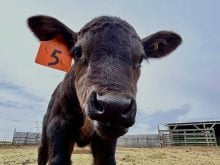In the last few years, many beef producers have taken advantage of corn residue as part of their cow herd’s overwintering feeding program. It’s a low-cost feed and for the most part, because early-gestating cows are allowed months of grazing without much trouble. Unfortunately, this wet fall has presented many challenges in feeding lower-quality corn residue and in displaying a likely chance of serious mould contamination. Different feeding strategies should be in place as the winter progresses.
The nutrient value of corn residue should compare to other low-cost feeds, including similar standing corn fed to overwintering beef cows.
Read Also

Harvest wraps up and fall work begins
At the Eppich famly ranch in western Saskatchewan, the fall harvest was successful with few breakdowns, cows and calves have been sorted and a new tractor has arrived
Good corn residue is very comparable to wheat or barley straw and can support the nutrient requirements of gestating beef cows with the right amount and type of nutrient supplements. Specifically, early- to mid-gestation cows need to consume about 52-55 per cent TDN and eight to nine per cent crude protein feed daily for body maintenance, to keep warm and to support an early-term fetus. Overwintering pre-calving cows need about 55-60 per cent TDN and nine to 11 per cent crude protein to also maintain body condition, to survive winter, support a late-term fetus and to get ready for calving.
Earlier this winter I walked into a few corn residue fields being grazed by cattle. The corn leaves left over from harvest looked like straw, cornstalks snapped like kindling and the dropped cobs had corn kernels; either hard pebbles or were mushy. These observations only confirm my belief that this fall’s wet weather produced corn residue of lower nutrient value.
I also expect such limited nutrition will decrease further as the winter progresses. That’s because beef cows are selective feeders and tend to graze only the most palatable portions of the corn residue first and leave the worst parts until they absolutely are forced to eat it. Winter weather also plays havoc with corn residue and thereby tends to degrade all existing plant material.
Supplements available
The good news is that there are many energy and/or protein feed supplements available, which should complement overwintering cow feeding programs based upon grazing low-quality corn residue. For example, many producers across Western Canada have access to dried distillers grains, which is both a good energy and protein feed; 75 per cent TDN and 28 per cent crude protein. Adding four lbs. of DDGS can raise a diet of 23 lbs. of corn residue from five to eight per cent protein and supply enough dietary energy for early and mid-gestation cows.
Only because this is a challenging year for feeding corn residue, I would make sure an increase in the plane of nutrition is put in place for the late-gestation or pre-calving cows. I would do this by substituting a portion of their corn residue diet with an adequate-quality forage.
For example, I would provide a grass hay or mixed grass-alfalfa mixtures with an energy TDN of 55-60 per cent TDN and protein level of 11-12 per cent. Some beef producers roll out bales of this better-quality forage right onto corn residue pastures.
Cold weather in January and February will further increase energy demands for overwintering cows just to keep warm, regardless of corn residue quality. An additional 0.5-1.0 kg of grain or DDGS should be provided. It is also important to purchase a well-balanced beef mineral with complementary levels of calcium and phosphorus, fortified with essential trace minerals and vitamins A, D, and E.
Watch for mould
In addition to lower feed quality, this year’s corn residue was very susceptible to mould growth. In a few fields, I have seen corn leaves that were dotted with blue spots (penicillium mould?) and leftover corncobs with blue-green patches or furry white coats. Fortunately, most beef cows should stay away from mouldy feeds because infected corn is less palatable than available clean residue.
Then again, if the whole field is littered with mouldy corn cobs, stalks and leaves, gestating beef cows may have no choice but to eat contaminated feed, which can lead to a substantial reduction in feed/nutrient intake. Significant mould levels will also lower feed digestibility as well as reduce energy and protein feed content. At their worst, some moulds such as penicillium can produce potent toxins called mycotoxins, which can induce abnormal metabolism, damage organs, infertility and literarily shut down the cattle’s entire immune system that fights disease.
Awareness of such mould contamination or of general lower-quality corn residue after a wet fall is a big leap forward in assuring that gestating beef cows remain healthy and meet their overwintering nutrient requirements. The next step is to take appropriate actions; avoid mouldy “hot-spots” in corn residue fields as well as supplement essential dietary nutrients where needed. If you do this, you should be able to stop and enjoy the practical and economic benefits of feeding corn residues to your beef cows.
















